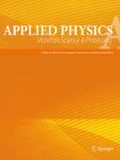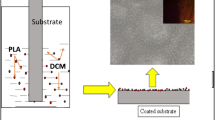Abstract
Bioceramic compositions based on zirconia/hydroxyapatite (HAP) modified with silver ions (Ag) at different additional zirconia nanoparticles were fabricated. The obtained compounds were characterized upon their structure using XRD and TEM, besides their morphological features using FESEM. Zirconia nanoparticles were trapped into HAP lattice for the as-prepared composition, however, for annealed one, zirconia was revealed as a separated crystalline phase. In the case of the annealed compositions, the a-axis was fluctuated from 9.436 to 9.440 Å, while the c-axis changed from 6.866 to 6.888 Å for the lowest and the highest zirconia additives. Furthermore, the crystal growth is preferred to be occurred in c-direction, while the porosity content increased from 21.9 to 33.5%. The surface morphology illustrated as rod shapes for as-prepared compositions, while hexagonal-shaped were observed for annealed ones. Zirconia nanoparticles were formed in spherical shapes with diameters about 0.15–0.21 μm. Moreover, the cell viability was examined in vitro for osteoblasts cell lines and the inhibition zone was also measured against both Escherichia coli (E. coli) and Staphylococcus aureus (S. aureus).








Similar content being viewed by others
References
K. Zheng et al., Antioxidant mesoporous Ce-doped bioactive glass nanoparticles with anti-inflammatory and pro-osteogenic activities. Mater. Today Bio 5, 100041 (2020)
H.-L. Yao et al., Structure, mechanical and bioactive properties of nanostructured hydroxyapatite/titania composites prepared by microwave sintering. Mater. Chem. Phys. 241, 122340 (2020)
M.F. Abdelbar et al., Highly ordered functionalized mesoporous silicate nanoparticles reinforced poly (lactic acid) gatekeeper surface for infection treatment. Int. J. Biol. Macromol. 156, 858–868 (2020)
C. Zhang et al., Nest-like microstructured biocompatible membrane fabricated by hydrothermally-synthesized hydroxyapatite (HAp) whiskers. J. Eur. Ceram. Soc. 40(2), 513–520 (2020)
K. Zawisza et al., Preparation and preliminary evaluation of bio-nanocomposites based on hydroxyapatites with antibacterial properties against anaerobic bacteria. Mater. Sci. Eng. C Mater. Biol. Appl. 106, 110295 (2020)
M.T. Elsayed et al., Morphological, antibacterial, and cell attachment of cellulose acetate nanofibers containing modified hydroxyapatite for wound healing utilizations. J. Mater. Res. Technol. 9(6), 13927–13936 (2020)
H. Wang et al., Integrative treatment of anti-tumor/bone repair by combination of MoS2 nanosheets with 3D printed bioactive borosilicate glass scaffolds. Chem. Eng. J. 396, 125081 (2020)
S. Rethinam et al., Enhanced tissue regeneration using an nano-bioactive scaffold: A novel perspective. Mater. Chem. Phys. 240, 122303 (2020)
T. Zaharescu et al., Size particle effects on the thermal stability of poly(lactic acid)/hydroxyapatite hybrids for biodegradable package. Ceram. Int. 46(6), 7288–7297 (2020)
R.A. Youness, M.A. Taha, M.A. Ibrahim, In vitro bioactivity, molecular structure and mechanical properties of zirconia-carbonated hydroxyapatite nanobiocomposites sintered at different temperatures. Mater. Chem. Phys. 239, 122011 (2020)
A.A. El-Bindary et al., Metal–organic frameworks as efficient materials for drug delivery: Synthesis, characterization, antioxidant, anticancer, antibacterial and molecular docking investigation. Appl. Organomet. Chem. 34(11), e5905 (2020)
A.A. Menazea, S.A. Abdelbadie, M.K. Ahmed, Manipulation of AgNPs coated on selenium/carbonated hydroxyapatite/ε-polycaprolactone nano-fibrous via pulsed laser deposition for wound healing applications. Appl. Surf. Sci. 508, 145299 (2020)
S.F. Mansour et al., Microstructural, morphological behavior and removal of Cr(VI) and Se(IV) from aqueous solutions by magnetite nanoparticles/PVA and cellulose acetate nanofibers. Appl. Phys. A (2020). https://doi.org/10.1007/s00339-020-3377-z
R. Al-Wafi, S.F. Mansour, M.K. Ahmed, Mechanical, microstructural properties and cell adhesion of Sr/Se-hydroxyapatite/graphene/polycaprolactone nanofibers. J. Thermoplast. Compos. Mater. (2020). https://doi.org/10.1177/0892705720912781
H.A. Radwan et al., Electrospun polycaprolactone nanofibrous webs containing Cu–Magnetite/Graphene Oxide for cell viability, antibacterial performance, and dye decolorization from aqueous solutions. Arab. J. Sci. Eng. (2021). https://doi.org/10.1007/s13369-021-05363-7
B.A. Al Jahdaly et al., Selenium nanoparticles synthesized using an eco-friendly method: dye decolorization from aqueous solutions, cell viability, antioxidant, and antibacterial effectiveness. J. Mater. Res. Technol. 11, 85–97 (2021)
R. Al-Wafi, M.K. Ahmed, S.F. Mansour, Tuning the synthetic conditions of graphene oxide/magnetite/ hydroxyapatite/cellulose acetate nanofibrous membranes for removing Cr(VI), Se(IV) and methylene blue from aqueous solutions. J. Water Process Eng. 38, 101543 (2020)
M.K. Ahmed et al., Au-doped carbonated hydroxyapatite sputtered on alumina scaffolds via pulsed laser deposition for biomedical applications. J. Market. Res. 9(4), 8854–8866 (2020)
M.K. Ahmed, A.A. Menazea, A.M. Abdelghany, Blend biopolymeric nanofibrous scaffolds of cellulose acetate/epsilon-polycaprolactone containing metallic nanoparticles prepared by laser ablation for wound disinfection applications. Int. J. Biol. Macromol. (2020). In press.
M.K. Ahmed et al., Tuning the composition of new brushite/vivianite mixed systems for superior heavy metal removal efficiency from contaminated waters. J. Water Process Eng. 34, 101090 (2020)
M.K. Ahmed et al., Composition and design of nanofibrous scaffolds of Mg/Se- hydroxyapatite/graphene oxide @ ε-polycaprolactone for wound healing applications. J. Market. Res. 9(4), 7472–7485 (2020)
M.K. Ahmed et al., Gold as a dopant in selenium-containing carbonated hydroxyapatite fillers of nanofibrous epsilon-polycaprolactone scaffolds for tissue engineering. Int. J. Pharm. 577, 118950 (2020)
I.S. Yahia, M. Shkir, S.M.A.S. Keshk, Physicochemical properties of a nanocomposite (graphene oxide-hydroxyapatite-cellulose) immobilized by Ag nanoparticles for biomedical applications. Results Phys. 16, 102990 (2020)
V.S. Yadav et al., Degradation kinetics and surface properties of bioceramic hydroxyapatite coated AZ31 magnesium alloys for biomedical applications. Mater. Let. 270, 127732 (2020)
S. Yadav, P. Singh, R. Pyare, Synthesis, characterization, mechanical and biological properties of biocomposite based on zirconia containing 1393 bioactive glass with hydroxyapatite. Ceram. Int. 46(8), 10442–10451 (2020)
T.-W. Wong et al., Bio-based composites from plant based precursors and hydroxyapatite with shape-memory capability. Compos. Sci. Technol. 194, 108138 (2020)
A. Veiga et al., Hydroxyapatite/sericin composites: a simple synthesis route under near-physiological conditions of temperature and pH and preliminary study of the effect of sericin on the biomineralization process. Mater. Sci. Eng. C 108, 110400 (2020)
C. Wang et al., Emission-tunable probes using terbium(III)-doped self-activated luminescent hydroxyapatite for in vitro bioimaging. J. Colloid. Interface Sci. 581(Pt A), 21–30 (2021)
Z.A. Al-Ahmed et al., Dye removal, antibacterial properties, and morphological behavior of hydroxyapatite doped with Pd ions. Arab. J. Chem. 13(12), 8626–8637 (2020)
S. Khan et al., Catechins-modified selenium-doped hydroxyapatite nanomaterials for improved osteosarcoma therapy through generation of reactive oxygen species. Front. Oncol. 9, 499 (2019)
Q. Zhou et al., Synthesis and characterization of silver nanoparticles-doped hydroxyapatite/alginate microparticles with promising cytocompatibility and antibacterial properties. Coll. Surf. A Physicochem. Eng. Asp. 585, 124081 (2020)
F. Liu et al., Hydroxyapatite/silver electrospun fibers for anti-infection and osteoinduction. J. Adv. Res. 21, 91–102 (2020)
M. Catauro et al., Morphological and thermal characterization of zirconia/hydroxyapatite composites prepared via sol-gel for biomedical applications. Ceram. Int. 45(2), 2835–2845 (2019)
A.S. Verma, D. Kumar, A.K. Dubey, Dielectric and electrical response of hydroxyapatite: Na0.5K0.5NbO3 bioceramic composite. Ceram. Int. 45(3), 3297–3305 (2019)
F.Y. Raji et al., Synthesis, structural, optical, dielectric properties, gamma radiation attenuation, and antimicrobial activity of V-doped hydroxyapatite nanorods. Mater. Today Commun. (2020). https://doi.org/10.1016/j.mtcomm.2020.101981
A.A. Hendi, F. Yakuphanoglu, Dielectric and ferroelectric properties of the graphene doped hydroxyapatite ceramics. J. Mol. Struct. 1207, 127734 (2020)
M. Afifi et al., Physical, electrochemical and biological evaluations of spin-coated epsilon-polycaprolactone thin films containing alumina/graphene/carbonated hydroxyapatite/titania for tissue engineering applications. Int. J. Pharm. (2020). https://doi.org/10.1016/j.ijpharm.2020.119502
M.K. Ahmed et al., Complex relationship between alumina and selenium-doped carbonated hydroxyapatite as the ceramic additives to electrospun polycaprolactone scaffolds for tissue engineering applications. J. Alloy. Compd. 801, 70–81 (2019)
M.K. Ahmed et al., Tuning the mechanical, microstructural, and cell adhesion properties of electrospun ε-polycaprolactone microfibers by doping selenium-containing carbonated hydroxyapatite as a reinforcing agent with magnesium ions. J. Mater. Sci. 54(23), 14524–14544 (2019)
S.F. Mansour et al., Structure and cell viability of Pd substituted hydroxyapatite nano particles. Biomed. Phys. Eng. Expr. 4(4), 045008 (2018)
N.Z. Shaban et al., Design, DNA binding and kinetic studies, antibacterial and cytotoxic activities of stable dithiophenolato titanium(IV)-chitosan Nanocomposite. J. Mol. Liq. 287, 111002 (2019)
A.A. Menazea, A.M. Mostafa, E.A. Al-Ashkar, Effect of nanostructured metal oxides (CdO, Al2O3, Cu2O) embedded in PVA via Nd:YAG pulsed laser ablation on their optical and structural properties. J. Mol. Struct. (2019). https://doi.org/10.1016/j.molstruc.2019.127374
A.A. Menazea et al., Precipitation of silver nanoparticles in silicate glasses via Nd:YAG nanosecond laser and its characterization. J. Non-Cryst. Solids 513, 49–54 (2019)
N.Z. Shaban et al., Chitosan-based dithiophenolato nanoparticles: preparation, mechanistic information of DNA binding, antibacterial and cytotoxic activities. J. Mol. Liq. 318, 114252 (2020)
Statistical analyses were performed using MedCalc for Windows, v.M.S., Ostend, Belgium
I. Ullah et al., Synthesis, characterization and in vitro evaluation of zinc and strontium binary doped hydroxyapatite for biomedical application. Ceramics International (2020). https://doi.org/10.1016/j.ceramint.2020.02.242
J. Tian et al., Preparation and biological imaging of fluorescent hydroxyapatite nanoparticles with poly(2-ethyl-2-oxazoline) through surface-initiated cationic ring-opening polymerization. Mater. Sci. Eng. C Mater. Biol. Appl. 108, 110424 (2020)
M. Tavangar et al., Manufacturing and characterization of mechanical, biological and dielectric properties of hydroxyapatite-barium titanate nanocomposite scaffolds. Ceram. Int. 46(7), 9086–9095 (2020)
M. Sykes et al., Infected open calcaneal fractures: a delayed reconstruction technique using calcium sulphate and hydroxyapatite antibiotic elucidating void filler. J. Clin. Orthop. Trauma 11(3), 462–466 (2020)
S.A.P. Sughanthy, M.N.M. Ansari, A. Atiqah, Dynamic mechanical analysis of polyethylene terephthalate/hydroxyapatite biocomposites for tissue engineering applications. J. Market. Res. 9(2), 2350–2356 (2020)
P. Sricharoen et al., Ultrasonic-assisted recycling of Nile tilapia fish scale biowaste into low-cost nano-hydroxyapatite: ultrasonic-assisted adsorption for Hg(2+) removal from aqueous solution followed by “turn-off” fluorescent sensor based on Hg(2+)-graphene quantum dots. Ultrason. Sonochem. 63, 104966 (2020)
M. Socka et al., Preparation of biomimetic composites of hydroxyapatite and star-shaped poly(2,2-dimethyl trimethylene carbonate)s terminated with carboxyl end-groups. Polymer 186, 122078 (2020)
G. Singh et al., Design, development and tribological characterization of Ti–6Al–4V/hydroxyapatite composite for bio-implant applications. Mater. Chem. Phys. 243, 122662 (2020)
N. El-Desouky et al., Bio-inspired green manufacturing of plasmonic silver nanoparticles/Degussa using Banana Waste Peduncles: photocatalytic, antimicrobial, and cytotoxicity evaluation. J. Mater. Res. Technol. 10, 671–686 (2021)
S. Saire-Saire et al., Magnetic bio-nanocomposite catalysts of CoFe2O4/hydroxyapatite-lipase for enantioselective synthesis provide a framework for enzyme recovery and reuse. Int. J. Biol. Macromol. 148, 284–291 (2020)
S. Sahmani et al., Effect of magnetite nanoparticles on the biological and mechanical properties of hydroxyapatite porous scaffolds coated with ibuprofen drug. Mater. Sci. Eng. C Mater. Biol. Appl. 111, 110835 (2020)
Author information
Authors and Affiliations
Corresponding author
Ethics declarations
Conflict of interest
The author declares that there is no conflict of interest.
Additional information
Publisher's Note
Springer Nature remains neutral with regard to jurisdictional claims in published maps and institutional affiliations.
Rights and permissions
About this article
Cite this article
Alturki, A.M. Morphological, structural, microstructural and antibacterial features of silver-doped zirconia/hydroxyapatite for biomedical applications. Appl. Phys. A 127, 416 (2021). https://doi.org/10.1007/s00339-021-04565-y
Received:
Accepted:
Published:
DOI: https://doi.org/10.1007/s00339-021-04565-y




